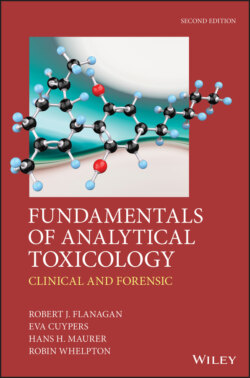Читать книгу Fundamentals of Analytical Toxicology - Robin Whelpton - Страница 27
1.3.4 Quality control and quality assessment
ОглавлениеOnce an analytical method has been validated and implemented it is important to be able to show that the method continues to perform as intended. In qualitative work, known positive and negative specimens should normally be analyzed in the same analytical sequence as the test sample. A negative control (‘blank’) helps to ensure that false positives (owing to, for example, contaminated reagents or glassware, or carry-over from a previous analysis) are not obtained. Equally, inclusion of a true positive serves to check that any reagents have been prepared properly and have remained stable.
Table 1.6 Terms used when reporting method validation
| Term | Notes |
| Accuracy | The difference between the measured value and the accepted (‘true’) value |
| Calibration range | The range of concentrations between the highest and lowest calibration standards. This should encompass the range of concentrations found in the test samples |
| Carry over | Signal from the last sample analysis enhancing response in the next analysis |
| Carry under | Signal from the last sample analysis reducing response in the next analysis |
| Coefficient of variation (CV) | An alternative term for relative standard deviation (RSD) |
| ‘Cut-off’ | An analyte concentration above or below which positive results are not reported (see Section 18.1.2) |
| Higher or upper limit of quantification (HLoQ/ULoQ) | The highest concentration that can be quantified. Not always quoted, but important in assays with a clear upper limit to a calibration graph, for example immunoassays and fluorescence assays |
| Internal quality control (IQC) | A sample of known analyte concentration that is analyzed as if it were a real sample |
| Internal standard (ISTD) | A second compound, not the analyte, added at an appropriate stage in the assay to correct for systematic errors in the analysis |
| Lower limit of detection/limit of detection (LLoD/LoD) | The smallest amount of analyte that can be detected. Usually defined as some multiple (5 for example) of the baseline noise (signal to noise ratio = 5) or a multiple of the standard deviation (SD) of the blank signal |
| Linearity | A definable and reproducible relationship between a physicochemical measurement (e.g. UV absorption) and the concentration of the analyte. Not necessarily a straight line |
| Lower limit of quantification/limit of quantification (LLoQ/LoQ) | The lowest concentration that can be measured within defined limits. Usually a concentration for which the precision and accuracy have been set arbitrarily, e.g. RSD <20 % |
| Measurement uncertainty (MU) | The 95 % confidence interval of the sum of the IQC RSD values given by an assay over a defined period |
| Precision | The scatter of measured values about a mean value. Usually quoted as RSD – within-assay and between-assay precision is commonly given |
| Relative standard deviation (RSD) | The standard deviation of replicate measurements expressed as a percentage of the mean value: RSD = SD/Mean x 100 % Useful when comparing precision at different concentrations |
| Selectivity | The ability to distinguish between the analyte and some other compound |
| Signal to noise (S/N) ratio | Strictly, the response to the analyte divided by the amplitude of random electronic noise of the detection system. In practice, the background signal due to interfering compounds is often greater than the electronic noise |
In quantitative work, assay performance is monitored by the systematic analysis of internal quality control (IQC) samples, independently prepared standard solutions of known composition prepared in the same matrix as the samples and not used in assay calibration. Plotting the results for the IQC samples on a chart allows the day-to day performance of the assay to be monitored and gives warning of any actual or impending problems. When new batches of calibration and IQC samples are prepared it is prudent to ensure comparability of the results obtained with those given by an earlier batch, or with the results obtained using external QC material.
An important parameter in the routine use of a method is measurement uncertainty (MU). This is expressed as ±1.96 CV %, in other words the 95 % confidence interval of the sum of the IQC CV values given by an assay over a defined period (Section 3.2.3.4). An especial issue concerns accuracy at a limit defined in legislation such as drink- and drugs-driving legislation. Here it is good practice to allow 3 SDs error (99.9 % of measurements will be either at, or above the limit) before reporting a positive result as a ‘not less than’ concentration.
Participation in appropriate external quality assessment (EQA)/proficiency testing (PT) schemes is also important. In such schemes, (sometimes lyophilized) plasma, serum, whole blood, urine, or hair specimens are sent to a number of participating laboratories. After reconstitution in deionized water if appropriate, the specimens are analyzed as if they were real samples and the results are reported before the true or target concentrations are made known (Section 3.6.2).
